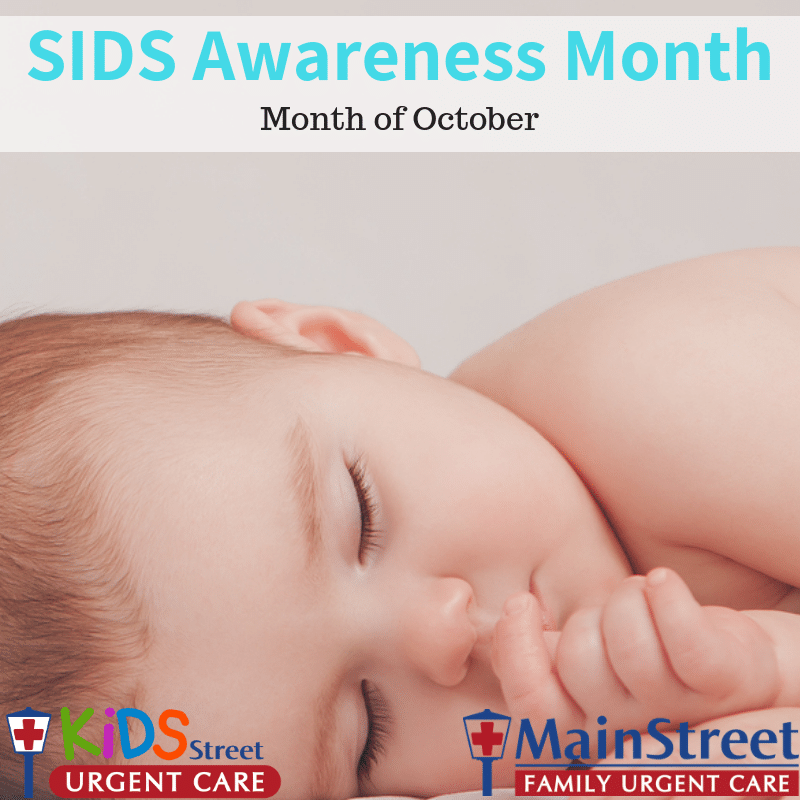
October is SIDS Awareness Month. SIDS (Sudden Infant Death Syndrome) is the unexplained death of a seemingly healthy baby, typically under the age of one. Most of the time death happens while sleeping. SIDS is also known as crib death because children passing while in their crib. To create awareness, we’ve shared some basic information below surrounding Sudden Infant Death Syndrome.
What causes SIDS?
The cause of SIDS is unknown, however, studies have suggested certain factors could lead to SIDS. Some factors of SIDS include:
- Brain defects – defects in the portion of an infant’s brain that controls breathing and arousal from sleep
- Low birth weight
- Respiratory infection
- Sleeping on the stomach or side. Babies placed in these positions to sleep might have more difficulty breathing than those placed on their backs
- Sleeping on a soft surface
- Sharing a bed
- Overheating
- Boys are slightly more likely to die of SIDS
- Infants are most vulnerable between the second and fourth months of life
- For reasons that aren’t well-understood, nonwhite infants are more likely to develop SIDS
- Babies who’ve had siblings or cousins die of SIDS are at higher risk of SIDS
- Babies who live with smokers have a higher risk of SIDS
How can SIDS be prevented?
Back to sleep
Place your baby to sleep on his or her back, rather than on the stomach or side, every time you — or anyone else — put the baby to sleep for the first year of life. This isn’t necessary when your baby’s awake or able to roll over both ways without help.
Don’t assume that others will place your baby to sleep in the correct position — insist on it. Advise sitters and child care providers not to use the stomach position to calm an upset baby.
Keep the crib as bare as possible.
Use a firm mattress and avoid placing your baby on thick, fluffy padding, such as lambskin or a thick quilt. Don’t leave pillows, fluffy toys or stuffed animals in the crib. These can interfere with breathing if your baby’s face presses against them.
Don’t overheat your baby.
To keep your baby warm, try a sleep sack or other sleep clothing that doesn’t require additional covers. Don’t cover your baby’s head.
Have your baby sleep in your room.
Ideally, your baby should sleep in your room with you, but alone in a crib, bassinet or other structure designed for infants, for at least six months, and, if possible, up to a year.
Adult beds aren’t safe for infants. A baby can become trapped and suffocate between the headboard slats, the space between the mattress and the bed frame, or the space between the mattress and the wall. A baby can also suffocate if a sleeping parent accidentally rolls over and covers the baby’s nose and mouth.
Breast-feed your baby, if possible.
Breastfeeding for at least six months lowers the risk of SIDS.
Don’t use baby monitors and other commercial devices that claim to reduce the risk of SIDS.
The American Academy of Pediatrics discourages the use of monitors and other devices because of ineffectiveness and safety issues.
Offer a pacifier.
Sucking on a pacifier without a strap or string at naptime and bedtime might reduce the risk of SIDS. One caveat — if you’re breastfeeding, wait to offer a pacifier until your baby is 3 to 4 weeks old and you’ve settled into a nursing routine.
If your baby’s not interested in the pacifier, don’t force it. Try again another day. If the pacifier falls out of your baby’s mouth while he or she is sleeping, don’t pop it back in.
Immunize your baby.
There’s no evidence that routine immunizations increase SIDS risk. Some evidence indicates immunizations can help prevent SIDS.
Source: Mayo Clinic
MainStreet Family Care and KidsStreet Urgent Care is here for you and your family. For more information visit our websites: MainStreet & KidsStreet






